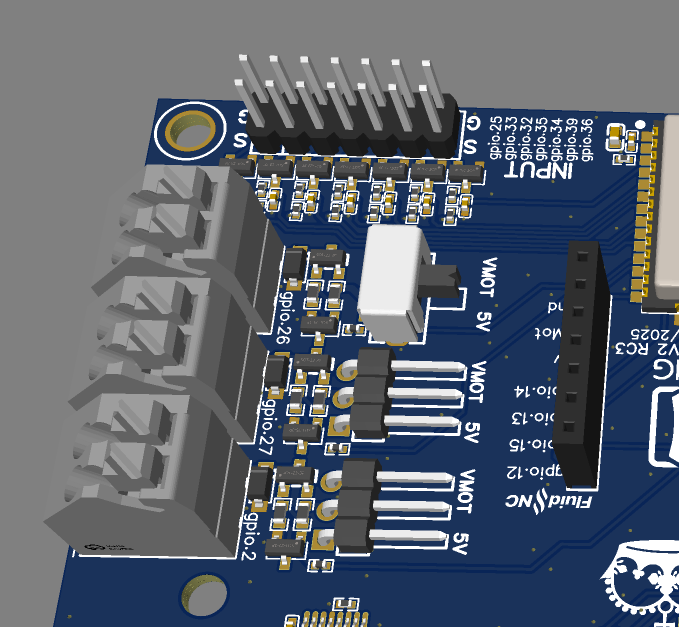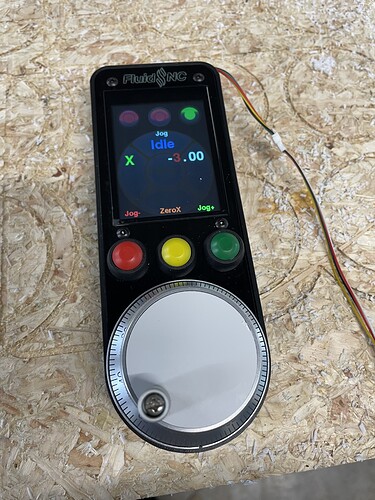I’m interested in this what would I look for for android, or windows? I hesitate to tell people to do this with their main machines but if it is just a shop machine this seems okay.
Seems like the perfect application for a block of dip switches.
I have no experience with it, but Claude.ai claims that you can set “driver_monitoring: true” for the driver and get console logging.
Claude.AI Response to "Is there a way to detect a driver shutdown of a TMC 2209 in uart mode using FluidNC?"
Yes, there are several ways to detect driver shutdown of a TMC2209 in UART mode using FluidNC. The TMC2209 provides status information through its UART interface that FluidNC can monitor.Here are the main approaches:
Reading Driver Status Registers
The TMC2209 has several status registers that indicate fault conditions:
- DRV_STATUS register - Contains flags for overtemperature, short circuits, and driver errors
- GSTAT register - Global status including driver error and reset flags
FluidNC can periodically read these registers via UART to detect shutdown conditions.
Configuration in FluidNC
In your FluidNC configuration, you can enable TMC driver monitoring:
axes:
x:
motor0:
tmc_2209:
uart:
txd_pin: gpio.17
rxd_pin: gpio.16
baud: 115200
addr: 0
r_sense: 0.11
run_current: 0.8
microsteps: 16
stallguard_threshold: 10
driver_monitoring: true # Enable status monitoring
Monitoring Methods
FluidNC provides several ways to detect driver issues:
- Automatic status polling - FluidNC can periodically check driver status
- Error reporting - Driver faults are reported through the console/web interface
- Stall detection - Can detect motor stalls which may indicate driver issues
Status Flags to Monitor
Key status flags that indicate driver shutdown:
otpw- Overtemperature pre-warningot- Overtemperature shutdowns2ga/s2gb- Short to grounds2vsa/s2vsb- Short to supply voltageola/olb- Open load
Accessing Status Information
You can query driver status through:
- G-code commands (if implemented)
- Web interface status display
- Serial console commands
- Custom FluidNC plugins
The exact implementation depends on your FluidNC version and configuration. Check the FluidNC documentation for your specific version to see which TMC monitoring features are available and how to enable them.
There are pre-warning and shutdown thermal thresholds. See page 68: https://www.analog.com/media/en/technical-documentation/data-sheets/tmc2209_datasheet_rev1.09.pdf
Edited to add: page 69 also indicates that overtemp triggers the diag pin. Perhaps you could attach some latching relays.
Thinking about this… me thinks that FluidNC should (not saying that it does, but should) detect this and stop the program.
I went there first and they are just two pin on or off. These are SPDT, on a reel, handle up to 50v, hanxia SK12D07VG3-T Pinout Diagram & Footprint Diagram | LCSC Electronics $0.04 each, Looks good to me.
That works-ish. The thing I dislike about those style of switches is that it’s sometimes hard to tell which position they are in because they move so little, particularly when they’re in that orientation, rather than facing upwards… but are probably better to be in that orientation so they don’t get accidentally toggled.
I was thinking about something like these: 76STC04T | Grayhill | Price | In Stock | LCSC Electronics
…but they’re stupid expensive and only 30V 0.15A.
Can LCSC not supply the jumpers already installed?
nope, that is what I was thinking when I put them on…such a bummer.
Looking at the image of the board in the very first post, and thinking about the yellow brick road, have you considered changing the silkscreen labels for the stepper motor headers to X1 (or Xmin) and X2 (or Xmax) rather than X and A, etc.
Problem with that is it would have to be different for the LR4 vs the Primo. So for that reason its probably best to leave it how it is and explain it in the docs.
Hell, do that next!
Not quite. The V2 has 4 GPIOs on the expansion connector instead of two. This might be quite useful.
Maybe V2 is the more expandable board.
I need to noodle on that a bit
They both have 4 right?
Oh, shoot. Right.
It’s Bart’s integrated 4driver board that went down to two.
I think We need a pin swizzler expansion carrier to take best advantage of those 4 GPIOs.
Technically yes, but not really. The trace layout, width and impedance all matter quite a lot for avoiding signal reflections etc.
I don’t know how much performance you’d get relative to a ‘proper’ connection, but I’d wager maybe 50%?
I can’t really keep up with the pace this thread as going due to being asleep during most of it.
This is not a ‘little bit’ issue, this is a tens to hundreds of m of extra range, +20dBm, lossy slow connection to rock solid connection difference. Not in every case because there can be other issues, but in enough cases that I’m very selective in where I’d ever use a PCB antenna now.
There are plenty of reasons to do it or not. ‘It won’t do much’ is categorically not a valid consideration. I cannot stress that enough.
Those look like you’ve found quite a non-standard part, to me. They should be a lot cheaper, probably not much more performance, though.
Hmmm, okay. Well getting rid of the jumpers helps, hundreds of Meters of extra range seems real nice. I will do my best to run a test tomorrow to see if I can notice a difference from my internal antenna jv1 to the external jv2. If it is substantial, I will consider it. Having the jv1 for external and the jv2 for simple to ship also sounds really nice. I can produce them, and ship them international direct, saving some people $100+ in shipping and tarrifs. If I have to have people source their own antenna that is a bummer.
Does that esp32 pop if there is no antenna plugged in? I guess I need to test that as well as that is 100% unacceptable.
How is the ESP32’s firmware uploaded before they’re shipped international direct? IF you decide on external whip, can whoever is burning firmware (and testing before ship) also pack the antenna too?
They can its all just an added cost. We have an external antenna option now, we’ll have to see if another is worth it.
I have 2 of them. One on my MPCNC and one on my LR4. I started with the M5, but didn’t like the dial on it. The CYD dial is much better.
Cool, I have a couple of the screens, I need to grab the fancy dial and the cheap dial and give it a shot.
I’ve a CYD pendant too and I agree, I much prefer it to the m5dial.
The jog wheel is more responsive - I can leave it on single mm and sprin it fast enough to really move.
It’s also smooth enough that I can use it one handed while squinting at the end of the bit ![]()
That may be an exaggeration, but a hundred metres with line of sight and a decent antenna is feasible. More with directional stuff but that’s not relevant here, really.
No, not at all.
One thing that it might be worth noting is that I’m not using any original ESP32s with external antennas, only the later ESP32-S3 and ESP32-C3 modules from Seeed Studios. I have no idea if there are any radio differences there that would also account for the difference in performance I’ve seen.

